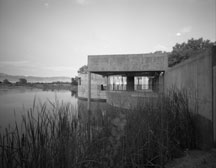
Rio Grande Nature Center and Preserve, Albuquerque, New Mexico, 1982 |
GHB: You mention Po Mo dangers and problems. You are not too distant in age from myself, so we came up when the Modern Movement was very big, certainly when I was a student in the fifties, and I dare say it was with you. I sense, and I may be right or wrong here, that you’re wanting to go the emotional route, but you’re still perhaps keen to preserve the principles of Modernism that directed it in its first instance and that have since been continuously overlaid, as in your case its been overlaid with your own levels of mysticism and fantasy. Am I right in assuming that the Modern Movement is still down there as a base?
AP: Yes, it would be, with many qualifications. I see
it as my fundamental beginning. I had no idea that there was modern architecture
except in a cartoon version in my mind when I was a young student, and
those principles that were taught at UNM, those early Modernist principles,
were fundamental to my background. In a way though, those Modernist tenets
are just as dangerous as Po Mo – and I’m thinking of negative
Post Modern nostalgic tenets in architecture. Post Modernism in the other
arts doesn’t always mean nostalgia, it doesn’t always mean
blatant nostalgic reference. I think Post Modernism collectively in the
arts is a movement that is integral and significant. Leaning on Modernist
tenets is not a lot different from leaning on stylistic nostalgia or nostalgia
for post-structuralist theories.
I think the thing about great modern buildings is that they have something
within their content that diverges from any theoretical direction that
might have been overtly established and articulated. There is always some
other quality – a quality of power, sometimes subtle, a quality
of an intangible sense of timelessness that distances the great works
from the doctrinaire works that follow compositional notions, and systems
of proportion or theory, rather blindly. Is this the ‘emotional
route’ that you refer to, Geoffrey?
GHB: Can you give me an example of this?
AP: When I stand on the axis of the Salk Institute, I feel I am in a space that is for all time – for the ages – it doesn’t matter whether Salk has gone, whether they are developing the Institute as a taco factory, it does not matter. There’s a powerful connection to a place in the world, and to the cosmos. It is a sacred positioning that is oblivious to the programme. At the Salk Institute, Kahn built what he talked about with a vengeance (with a little help on the courtyard from Luis Barragán).
GHB: That reminds me of the way, sometimes, everything
an artist believes in, everything he has devoted his life to, can be ‘compressed’
into a single work. These works stand out like jewels in man’s evolutionary
progression – immediately I think of Corbusier’s Ronchamp
Chapel or Michelangelo’s Sistine Chapel ceiling.
In his essay, ‘Buildling, Dwelling Thinking’, Martin Heidegger
explains that our dwelling on earth can only be understood in relation
to ‘the primal oneness of earth and sky, divinities and mortals’.
We may easily miss the significance of this, but Heidegger explains earth
as ‘the serving bearer, blossoming and fruiting…rising up
into plant and animal’. The sky is ‘the vaulting path of the
sun, the course of the changing moon, the wandering glitter of the stars,
the years’ seasons and their changes, the light and dusk of day,
the gloom and glow of night…the drifting clouds and blue depth of
the ether.’ There is also our sense of divinities and of our own
mortality. He points out that we ‘save the earth, receive the sky
and await the divinities’ and that this profound sense of the way
we belong to the elements is somehow, mysteriously captured in the way
buildings gather in their own way, earth and sky, divinities and mortals.
Heidegger’s words seem extraordinarily apt here, because in your work I sense the same involvement – with the earth, the sky, the sun, moon and stars, even perhaps the divinities. Can you say something about this?